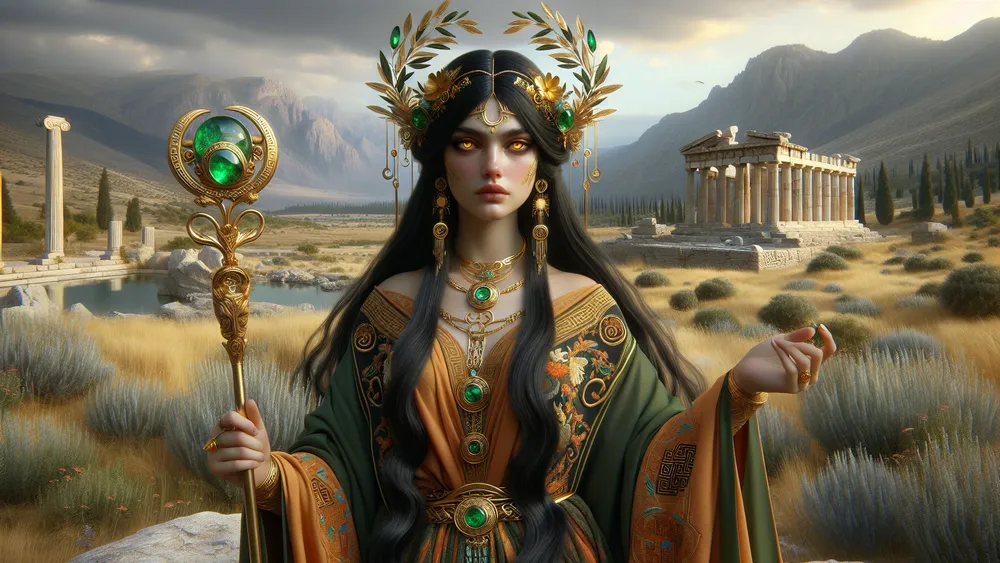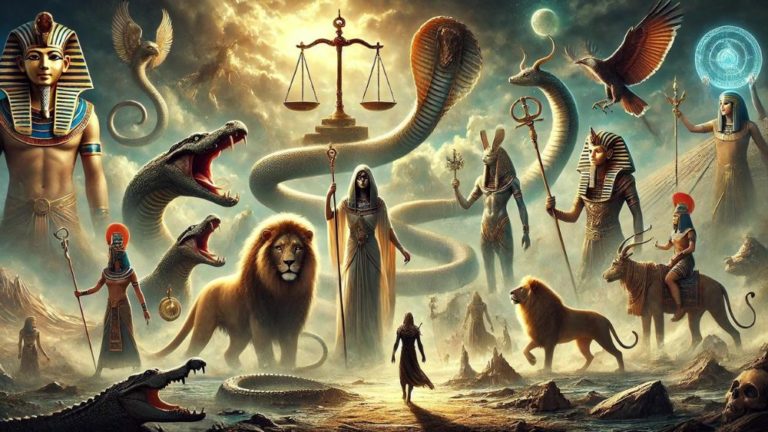Anatole (Anatolia): Eastern Roots And Myths In Greek Mythology
Greek mythology has been a key part of how people in the Western world tell stories and believe in big ideas. It shares many stories about gods, heroes, and the universe. But not as many people realize how deeply linked these myths are to Anatolia, which is now in Turkey, and the ancient people who lived there.
Key Points:
- Anatolia, now in Turkey, shaped Greek myths through shared stories and trade.
- Greek myths like Zeus’ rule and god battles linked to Hittite succession tales.
- Key myths like King Midas and Trojan War connect Greek and Anatolian cultures.
- Mount Ida and sacred rivers tied Anatolian geography to key Greek myths.
- Cybele, from Anatolia, influenced the Greek goddess Rhea’s worship.
- Abstract ideas like love and nature became living gods in Greek mythology.
- Myths from East and West merged to form richer, shared traditions.
The term “Anatolia” actually comes from the Greek word “Anatole.” That word means “East” or where the sun rises. This makes sense because Anatolia connected the East and West in important ways. It was a place where civilizations like the Hittites, Lydians, and Phrygians grew and developed. These groups made a lasting mark on Greek mythology. If you compare myths from both places, you will see many similarities.
This is likely because migration, trading, and exchanging of culture happened for hundreds of years. For example, very old myths about how the world came to be in Anatolia are older than – and may have shaped – Hesiod’s book, Theogony. What happened wasn’t just a passing exchange of ideas. Instead, both groups brought their own stories and beliefs, eventually combining them in ways that still remain important.
Today, we know that just like modern cultures borrow symbols and ideas from others, Greeks used Anatolian gods, worship of nature, and epic tales to tell their own stories. This long and complex connection helped to create a shared history. You can still feel the echoes of this past today.
Anatole-Anatolia: Overview and Key Facts
| Key Aspect | Details |
|---|---|
| Where it is | Anatolia, also called Asia Minor, is a big peninsula in what is now Turkey. It is next to the Aegean, Mediterranean, and Black Seas. |
| What the name means | The word “Anatolia” comes from the Greek word “Anatole,” which means “East” or “sunrise.” It refers to being east of the Greek area. |
| Why it matters historically | Many early civilizations, like the Hittites, Lydians, and Phrygians, lived there. These groups were active during early Greek times. |
| How it connected cultures | It connected eastern places such as Mesopotamia and Persia with western ones like Greece and Rome, sharing ideas, art, and religion. |
| Religious impact | Important gods, like Cybele (a Great Mother Goddess) and the storm god Tarhun, came from here and affected Greek beliefs. |
| Main civilizations | Groups like the Hittites, who had advanced laws and stories, and the Phrygians, who shaped myths like King Midas, lived in Anatolia. |
| Trade importance | Anatolia was at the center of old trade routes, where metals, clothing, and ideas about religion spread to the Aegean and far away. |
| Myths and their effects | Stories like the Hittite “Song of Kumarbi” changed how people told Greek tales, such as those in Hesiod’s Theogony. |
| Old ruins | Places like Hattusa, built by the Hittites, and Troy, connected to Homer’s books, prove how key Anatolia was in history and myth. |
| Landscapes in myths | Mountains like Mount Ida and rivers like Pactolus were part of myths and joined Greek ideas with stories from Anatolia. |
How the East Left Its Mark on Greek Mythology
Anatolia was a meeting place where ideas from the East and West were exchanged. It became important to many myths connected to ancient Greece. Because of this, the region influenced stories that are still talked about today. We can explore the exact details of how ideas from Anatolia had an effect on the myths told in ancient Greek times.
How Hittite and Anatolian Ideas Shaped Greek Myths
During the Bronze Age, from about 3000 to 1100 BCE, Anatolia became an essential place where cultures met and shared ideas. It was close to Greece, and because of this, people traded goods, art, and, most importantly, stories. In the same way people today share ideas across the world, the ancient Greeks took parts of Anatolian religion, ways of worship, and mythological ideas and used them within their own traditions.
For instance, the Hittites’ many gods and ideas about the universe had an effect on how the Greeks told stories. Another reason this happened was migration. People who moved from Anatolia brought myths with them, and later, these stories were changed and made into something new by the Greeks. Many Greek myths started with ideas that came from Anatolian mythology.
The Hittites focused on important natural elements like rivers, mountains, and storms in their religion, and this led the Greeks to also worship the earth, the weather, and the sky. Greek gods like Zeus, for example, were connected to ideas about storms and the heavens.
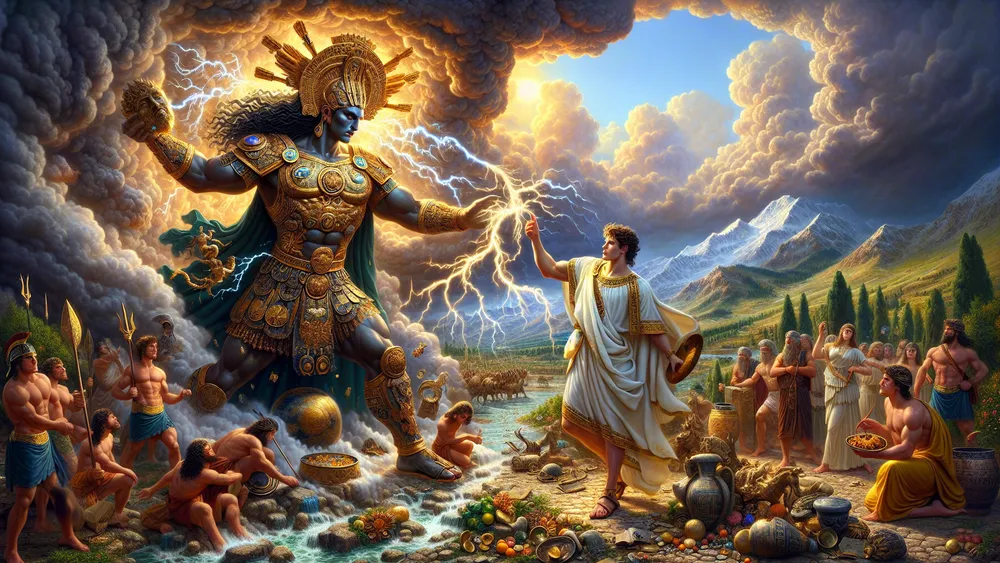
Stories from Anatolia were also similar to those in Greece, as each had tales about how gods fought with one another or took each other’s power. For instance, the Hittite “Song of Kumarbi” is about a god named Kumarbi, who took power from another god but was later challenged by the storm god Tarhun. A similar story appears in Hesiod’s Theogony, where Cronus overthrows Uranus, only for Zeus to later take power from Cronus.
These kinds of patterns in stories highlight how connected the two traditions were.
Some key ideas the Greeks borrowed from Anatolia include:
- Creation Myths: Stories like the Hittite “Song of Kumarbi” that inspired Greek creation tales.
- Shared Gods: Storm gods such as Tarhun (Hittite) and Zeus (Greek), and important mother goddesses like Cybele, who influenced the Greek goddess Rhea.
- Religious Practices: Worshipping natural things, such as rivers, storms, and mountains, which became a part of Greek sacred traditions.
- Godly Battles: Repeated themes of gods fighting for power, found in both Greek and Hittite stories.
By bringing these stories and practices together, Anatolia helped make Greek mythology richer. This sharing of ideas created many well-known myths that people still discuss today.
Greek mythology was deeply shaped by ideas from Anatolian myths, gods, and religious practices, shared through trade, migration, and cultural exchange.
Comparing Myths: What the Greeks Took from Hittite Stories
The stories from the Hittites and Greeks share many of the same ideas. They both deal with gods fighting and the transfer of power, including struggles between older gods and the gods who came later.
These similarities could mean that the Greeks borrowed ideas from the Hittites, or it may be that both cultures came up with similar stories on their own because people often focus on things like power and chaos. A clear example is the similarity between the Hittite “Song of Kumarbi” and the Greek story in Hesiod’s Theogony.
In the Hittite myth, Kumarbi, an ancient god, takes over from Anu, his father, by biting off part of his body. Afterward, Kumarbi ends up losing to the storm god Tarhun, who takes control. The Greek version is similar: Cronus removes part of Uranus, his father, and then Zeus, Cronus’s son, takes over.
These tales are about the same kinds of struggles for power and what gods do to fight one another.
There’s also the story of Illuyanka, a serpent-monster, fighting Tarhun, the storm god. This is similar to a Greek story about Typhon, a monster defeated by Zeus, another storm god. In both cases, the theme is about chaos, represented by the serpent-monster, and how it is brought under control by a god who uses storms and lightning to win. The two storm gods, Tarhun and Zeus, have a lot in common. Each one is seen as the most powerful god, and they both use lightning as a key weapon. The following table provides more examples:
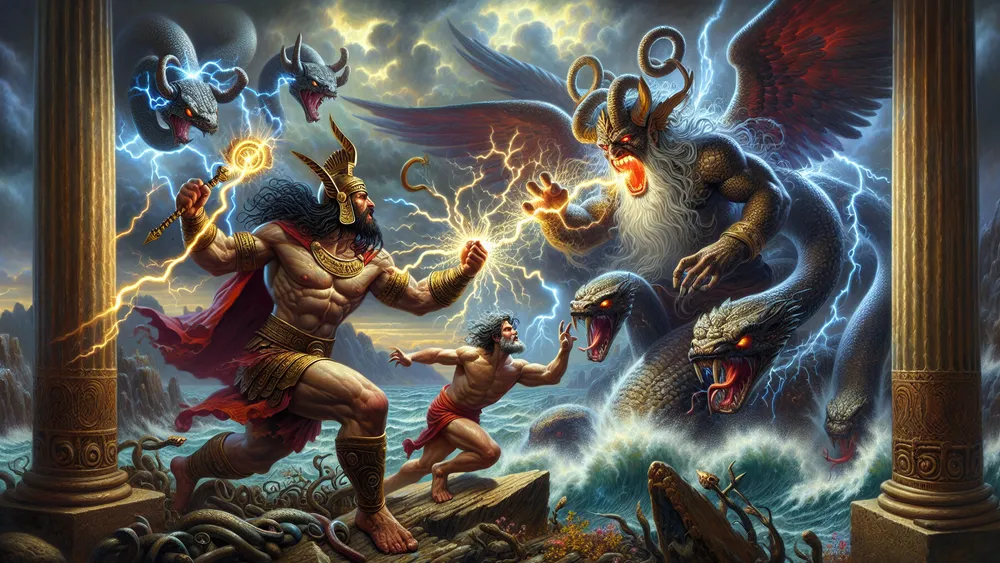
| Hittite Myth | Greek Myth | What They Have in Common |
|---|---|---|
| Kumarbi vs. Anu | Cronus vs. Uranus | Fighting fathers for power, using violence to take control of rule |
| Illuyanka (serpent) | Typhon (serpent) | Monsters that gods defeat to stop chaos and bring back peace |
| Tarhun (storm god) | Zeus (storm god) | Gods of storms and lightning who are the strongest and protect divine power |
By looking at these stories, it’s clear that both cultures cared about gods, power, and controlling disorder. These shared ideas helped Greek mythology grow and include ideas that came from other places, including the Hittites.
New Myths Born from Eastern and Western Traditions
Greek mythology, as it developed over time, mixed with Eastern ideas, creating new stories that brought together beliefs from different places. By bringing together Anatolian traditions and Greek myths, these stories became something new and unique. This connection between the two regions explains how their myths literally grew together into shared traditions. We can look closely at these myths. They mean more than just stories – they combine ideas from both the East and Greece.
These connections helped develop myths in a way that reflected how the two cultures influenced one another.
King Midas: A Story Rooted in Anatolia
The story of King Midas is a well-known example of the connection between Anatolia and Greek mythology. Midas was a king of Phrygia, an ancient kingdom found in western Anatolia. Over time, his life turned from history into myth. His famous story begins with Dionysus, a god who gave him a chance to make a wish.
This was because Midas had shown kindness by bringing back the satyr Silenus, who had gotten lost. Midas, never satisfied and always wanting more, asked that everything he touched become gold. At first, this seemed like a gift, but it was really a curse, because even his food and drink turned into gold, leaving him helpless.
Later, Dionysus helped him by telling him to wash his “golden touch” away in the River Pactolus. This river, near the old city of Sardis, became famous for its gold-filled sands. Some think this part of the story explains the river’s golden appearance. The story of King Midas means more than just describing the life of a historical figure.
His greed is an example of how wanting too much can create trouble, and his story also shows how it’s possible for people to change if they are willing to accept help and learn.
The Greeks included this tale in their larger mythology, making him a figure in their stories, but in Phrygia, he was admired as both a real historical figure and partly divine. The balance in his story between too much pride and the punishment that comes from it was often used in other Greek myths as well, though the river and the gold anchor the story firmly in Anatolia.
This tie to geography means the myth is shared by both cultures.
The Trojan War: Where East and West Collided
Troy, also called Ilion, was a vital place in both history and myths. It is in modern-day Turkey, near the Aegean Sea, and was located at a key spot where the cultures of Anatolia and nearby regions came together. In history, Troy was a major city in the Bronze Age.
In mythology, though, it became the focus of a famous story about war, culture, and the meeting of the Anatolian East and the Greek West. The Trojan War, a story told by the Greeks in Homer’s Iliad, turned Troy’s name into one people would remember forever. To the Greeks, this war symbolized the bigger struggle between people from the East and the West.
The war began when a Trojan prince, Paris, took Helen of Sparta, who was said to be the most beautiful woman in the world. Her husband, Menelaus, was a Greek king, and this caused him to call for other Greek leaders to help him bring her back.
The result was a long fight, with Achilles and Odysseus leading the Greeks, while King Priam, Hector, and other Trojans defended their city. Gods were also involved in the war – Apollo and Aphrodite helped the Trojans, while Athena and Hera supported the Greeks. Each side’s gods reflected the beliefs and values of their people. The war ended with the fall of Troy.
The Greeks used the idea of the Trojan Horse, a trick that let them attack from inside the city walls. This was not just the end of the war; it also told a story about how East and West shared and fought over cultural ideas. Troy, because of this war, became both a symbol of connection and conflict between the regions.
Through its location and legacy, Troy remains part of the shared history of Anatolia and Greece.

Niobe’s Tragic Tale: A Greek Myth with Anatolian Ties
Niobe was the daughter of Tantalus and is remembered as part of Greek mythology. Myths also connect her to Anatolia. Her story starts when she made fun of Leto, a goddess, for having only two children – Apollo and Artemis. Niobe, who had many children (some stories say 12, others 14), claimed she was better than Leto.
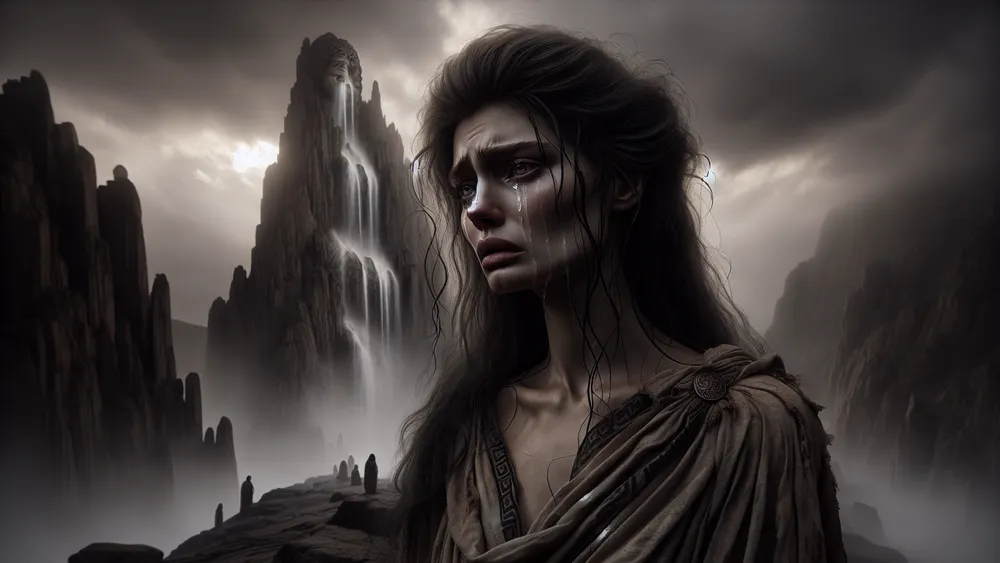
This insult to a goddess turned out to be a terrible mistake. In response, Apollo and Artemis went after her children, killing them to punish her pride and her insult to their mother. Because she could not bear the sadness of losing her children, Niobe escaped to Mount Sipylus in Anatolia. There, she was turned into stone.
People who visited the mountain said they could see a natural rock formation that looks like a woman crying. This rock, often called the weeping rock, was said to show Niobe’s eternal sorrow for her children. Her story, tied to this part of Anatolia, means more than just her pain. It explains the problems of too much pride and the heavy consequences it can bring.
Niobe’s tale warns about the harm caused by too much pride, as her insult to a goddess led to the loss of her children and her transformation into a weeping rock symbolizing endless grief.
Sacred Mountains, Rivers, and Myths: Anatolia’s Role
With its rocky mountains and wide rivers, Anatolia had many important places where myths developed. People in the past often saw landscapes like these as special. They believed these places connected their lives with the gods. By looking closely, it becomes clear how these areas became part of old stories that mixed everyday life with ideas about the divine.
Mountains, rivers, and other parts of the land were more than natural features – they were part of something bigger. Together, these places created ideas about the gods that people remembered and passed down.
Legendary Mount Ida: Where Mythology Comes Alive
Mount Ida is in northwest Anatolia and is a critical place in myths. Many well-known events from Greek stories happened there, and these stories mix ideas from both the East and West. One of the oldest myths about the mountain is about Zeus, the king of the gods. Some stories say that Mount Ida was where Zeus was kept safe after he was born.
A goat named Amalthea is said to have taken care of him to protect him from his father, Cronus, who wanted to hurt him. There is another mountain in Crete with a similar story, but the Anatolian version of Mount Ida is remembered as a shelter for important gods, which makes it clear that the region was part of early myths.
Later, another big event happened on Mount Ida. It was called The Judgment of Paris. Paris, who was a prince from Troy, had to decide which goddess was the most beautiful – Aphrodite, Athena, or Hera. He chose Aphrodite after she promised that he could have Helen, the woman whose love would eventually start the Trojan War. This decision, made on the mountain, connected Mount Ida to stories about the clash between East and West.
The mountain was connected to other myths too, besides Zeus and Paris. It was a special place used for rituals about Cybele, the Great Mother Goddess from Anatolia. People also said nymphs and gods lived there. These all come together to link Mount Ida to different stories, including:
- Zeus staying safe from Cronus when he was young.
- The Judgment of Paris, which caused the Trojan War.
- Rituals for Cybele, which showed Anatolia’s traditions.
- A place where gods and nymphs lived, which meant it was tied to divine stories.
In many ways, Mount Ida helps explain how myths and geography can work together and how they supported ideas shared by both Greek and Anatolian cultures.
Cybele: The Great Mother Goddess Shared by Two Cultures
Cybele, also called the Great Mother, was a central figure in religion from Anatolia. She was connected to ideas like fertility, nature, and the patterns of life and dying. People started worshiping her in the Bronze Age in places such as Phrygia, which is located in modern-day Turkey. She was shown as a strong and caring figure. Often, pictures of her included lions, showing her control over the natural world.
People celebrated her by organizing ceremonies that included music and excited dancing. These activities were thought to capture her strong and changing force. As time passed and cultures mixed, the worship of Cybele spread into Greek religion. Greek people connected her with Rhea, who was the mother of the gods in their own stories.
Many of the things Cybele represented were similar to Rhea’s traits, which made it easy for the Greeks to think of Cybele as a god who came before Rhea or as her counterpart. When Cybele’s worship moved into Greek culture, it still kept many of its Anatolian traditions.
For example, people still used the tympanum, a hand drum, during ceremonies and saw her as part of exciting rituals. But the way she was worshiped also changed. In Greece, she became connected to other cults, like those of Dionysus, which also focused on fertility. In this way, Cybele‘s worship helped mix ideas from Anatolian and Greek culture.
She became an example of how myths could change as cultures came together. Temples for Cybele, such as those in Pergamon and Athens, became places where important ceremonies and rituals happened. Her story means more than her Anatolian background.
Cybele’s lasting influence is a reminder of how religion in the Mediterranean was shared and developed, linking ideas from different places into a shared tradition.
All the Abstract and Natural Forces in Mythology
Greek mythology gave life to abstract ideas and things from nature, letting the ancient Greeks turn them into gods. Ideas that were hard to touch, like love, strife, and things that must happen, became gods like Eros, Eris, and Ananke. Things in the world, such as rivers, winds, and even the stars, were also seen as gods or spirits.
By doing this, the Greeks found ways to explain the powerful and often wild parts of their lives. To learn more about these amazing gods and the ideas they represent, check out this Greek Abstract and Natural Forces list.
FAQs
1. How did Anatolian myths contribute to Greek mythology?
Anatolian myths contributed to Greek mythology by inspiring foundational narratives, such as creation myths, succession struggles, and divine archetypes, through cultural exchange and shared cosmological themes.
2. Who was King Midas, and was he based on a real figure?
King Midas was a legendary Phrygian ruler tied to Greek and Anatolian mythology, and while elements of his story may reflect actual historical figures, the “golden touch” narrative is purely mythical.
3. What are the main parallels between Hittite and Greek mythology?
The main parallels between Hittite and Greek mythology include shared themes of divine succession, cosmic battles, and storm god archetypes that demonstrate a deep cultural exchange.
4. Why is Mount Ida important in both Anatolian and Greek myth?
Mount Ida is important in both Anatolian and Greek myth because it served as a sacred setting for key events like Zeus’ upbringing and the Judgment of Paris, symbolizing a bridge between the two cultures’ mythologies.

